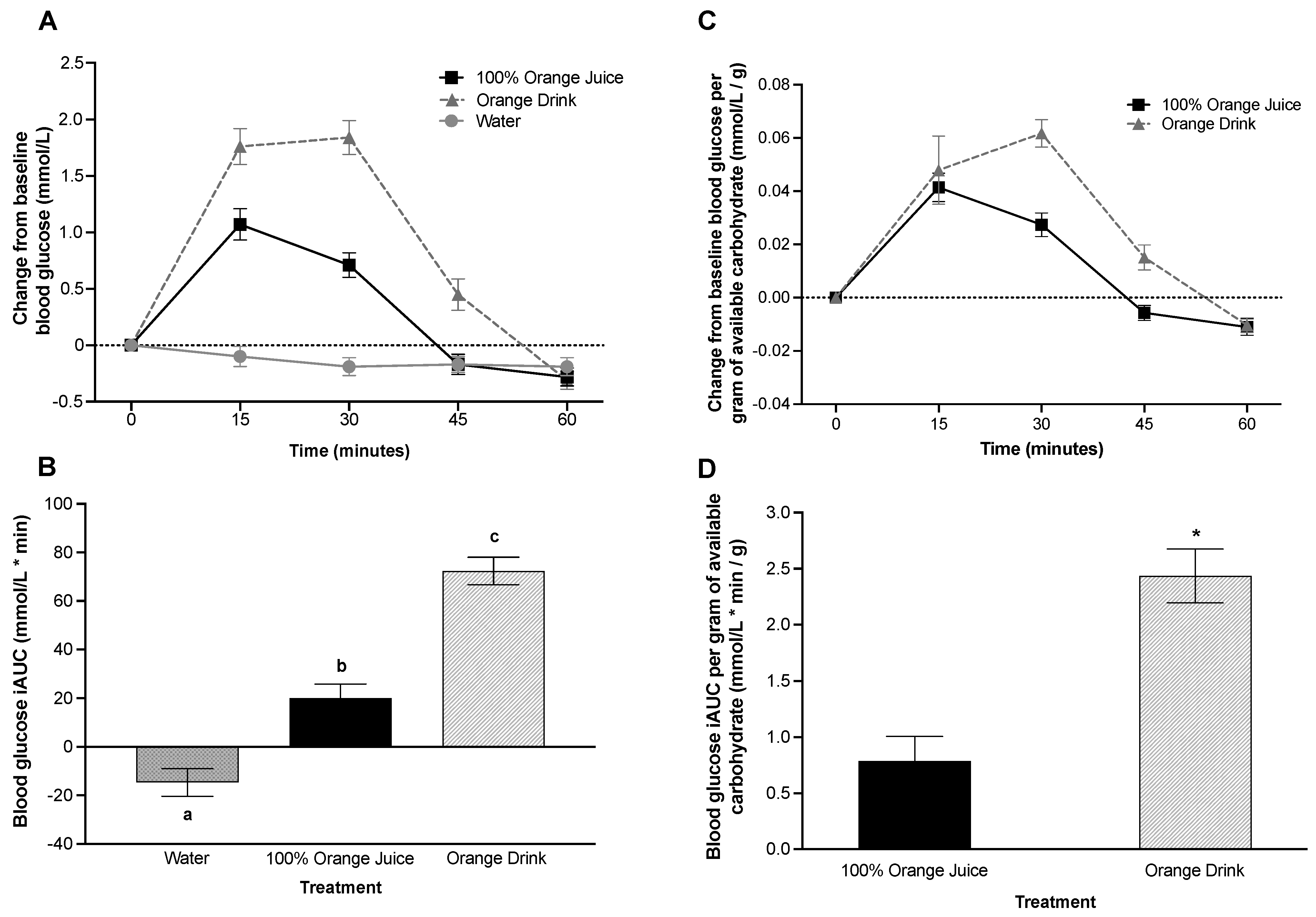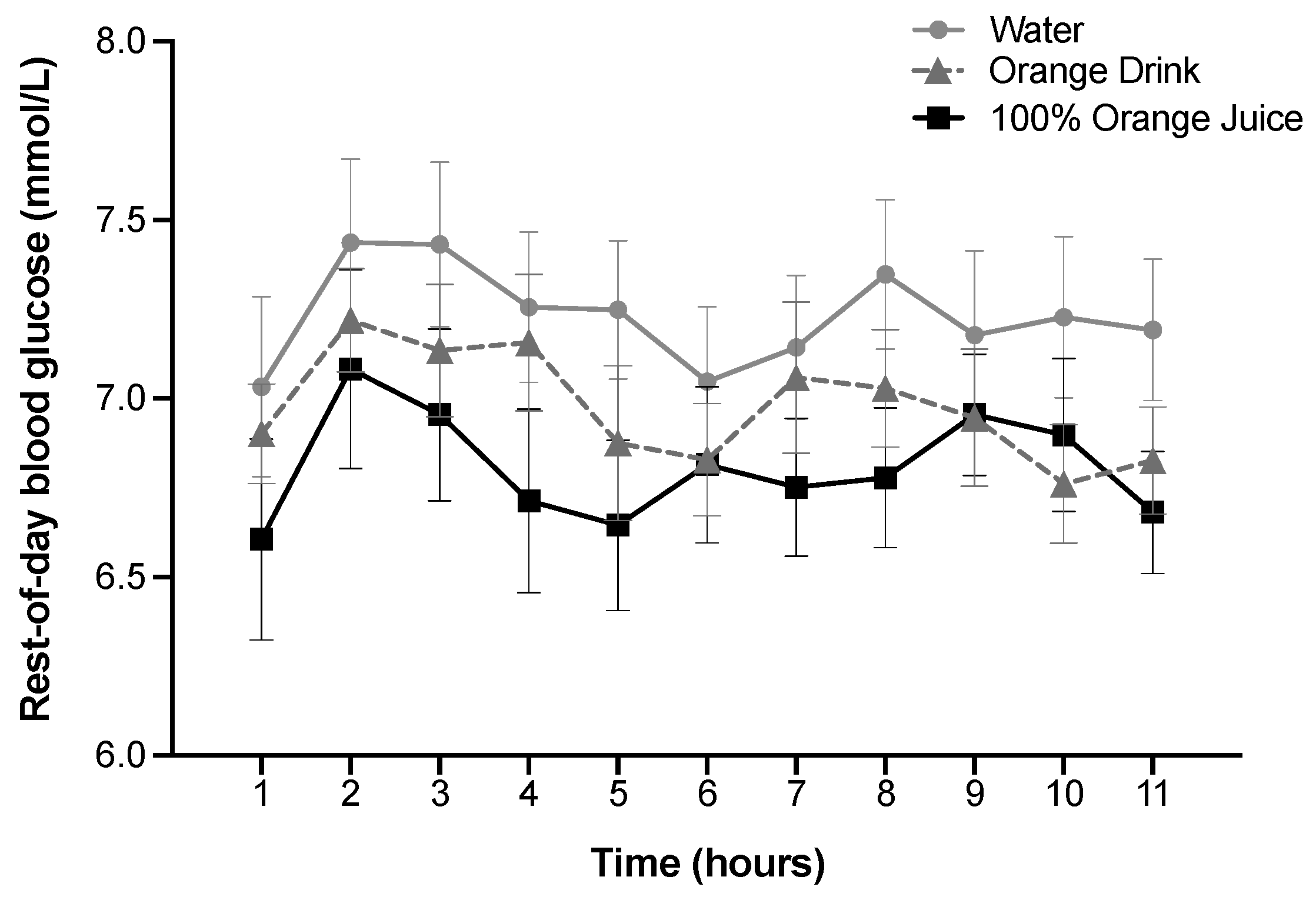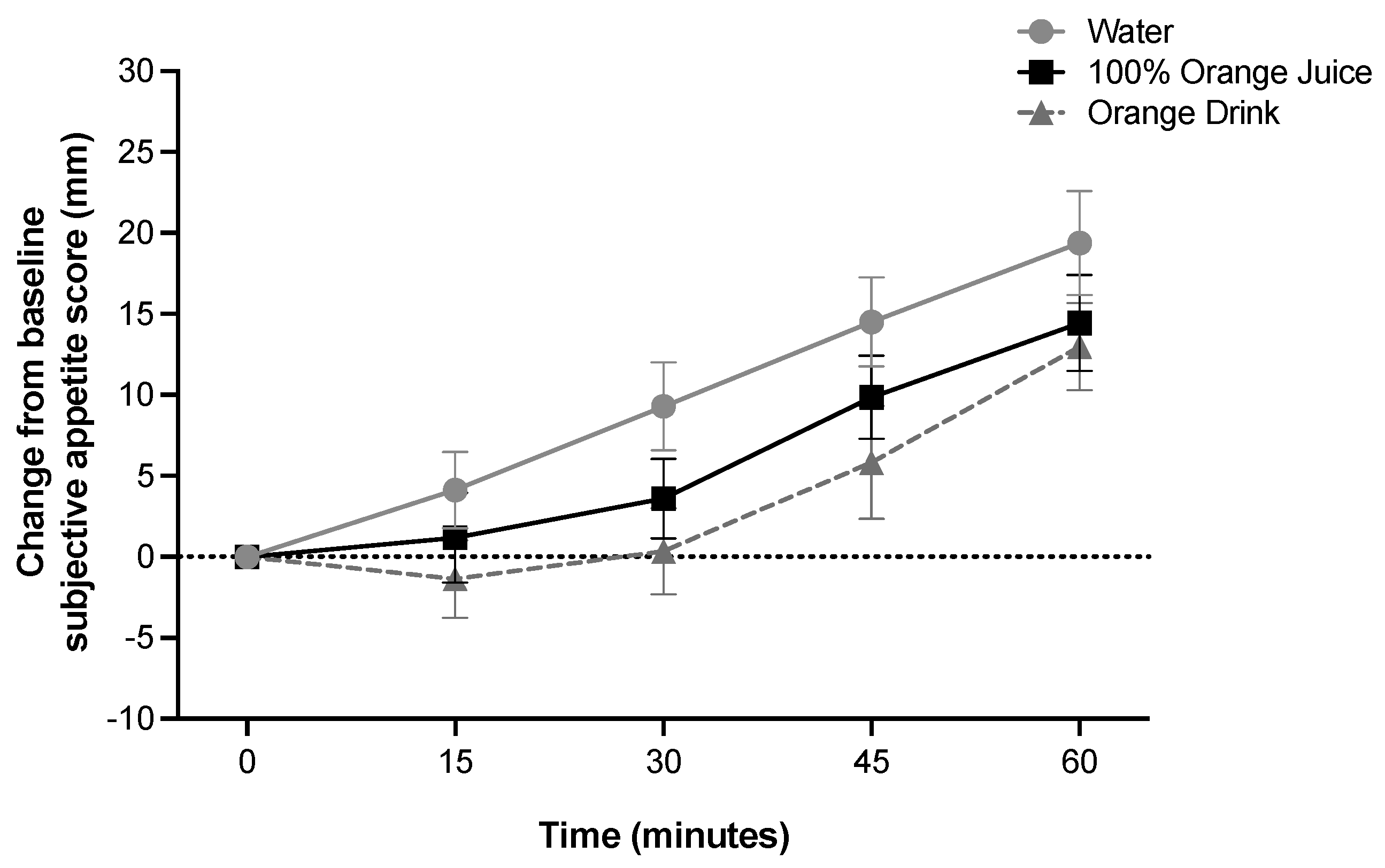Effect of 100% Orange Juice and a Volume-Matched Sugar-Sweetened Drink on Subjective Appetite, Food Intake, and Glycemic Response in Adults
Abstract
1. Introduction
2. Materials and Methods
2.1. Participants, Inclusion and Exclusion Criteria
2.2. Study Consent
2.3. Experimental Design
2.4. Experimental Procedures
2.4.1. Food and Water Intake
2.4.2. Rest-of-Day EI and Physical Activity
2.4.3. Post-Prandial Glycemic Response
2.4.4. Rest-of-Day Glycemic Response
2.4.5. Subjective Appetite, Subjective Emotions and Sensory Characteristics
2.5. Statistical Analyses
3. Results
3.1. Participant Characteristics
3.2. Food and Water Intake
3.3. Rest-of-Day EI
3.4. Rest-of-Day Physical Activity
3.5. Post-Prandial Blood Glucose Concentrations
3.6. Post-Prandial Blood Glucose Concentration per Gram of Available Carbohydrate in the Test Beverage
3.7. Rest-of-Day Glycemic Response
3.8. Subjective Appetite and Subjective Emotions
3.9. Sensory Characteristics of Treatments
3.10. Correlations
4. Discussion
5. Conclusions
Author Contributions
Funding
Institutional Review Board Statement
Informed Consent Statement
Data Availability Statement
Acknowledgments
Conflicts of Interest
References
- World Health Organization. Guideline: Sugars Intake for Adults and Children; World Health Organization: Geneva, Switzerland, 2015; pp. 1–65. [Google Scholar]
- Health Canada. Section 2: Foods and Beverages That Undermine Healthy Eating. In Canada’s Dietary Guidelines; Guidance Document 170463; Health Canada: Ottawa, ON, Canada, 2019; 62p, Available online: https://food-guide.canada.ca/en/guidelines/section-2-foods-and-beverages-undermine-healthy-eating/ (accessed on 27 October 2023).
- Rogers, P.J.; Carlyle, J.A.; Hill, A.J.; Blundell, J.E. Uncoupling sweet taste and calories: Comparison of the effects of glucose and three intense sweeteners on hunger and food intake. Physiol. Behav. 1988, 43, 547–552. [Google Scholar] [CrossRef] [PubMed]
- Rogers, P.J.; Blundell, J.E. Separating the actions of sweetness and calories: Effects of saccharin and carbohydrates on hunger and food intake in human subjects. Physiol. Behav. 1989, 45, 1093–1099. [Google Scholar] [CrossRef]
- Anderson, G.H.; Catherine, N.L.; Woodend, D.M.; Wolever, T.M. Inverse association between the effect of carbohydrates on blood glucose and subsequent short-term food intake in young men. Am. J. Clin. Nutr. 2002, 76, 1023–1030. [Google Scholar] [CrossRef] [PubMed]
- Woodend, D.M.; Anderson, G.H. Effect of sucrose and safflower oil preloads on short term appetite and food intake of young men. Appetite 2001, 37, 185–195. [Google Scholar] [CrossRef] [PubMed]
- Rolls, B.J.; Kim, S.; Fedoroff, I.C. Effects of drinks sweetened with sucrose or aspartame on hunger, thirst and food intake in men. Physiol. Behav. 1990, 48, 19–26. [Google Scholar] [CrossRef]
- DellaValle, D.M.; Roe, L.S.; Rolls, B.J. Does the consumption of caloric and non-caloric beverages with a meal affect energy intake? Appetite 2005, 44, 187–193. [Google Scholar] [CrossRef] [PubMed]
- Clemens, R.; Drewnowski, A.; Ferruzzi, M.G.; Toner, C.D.; Welland, D. Squeezing fact from fiction about 100% fruit juice. Adv. Nutr. 2015, 6, 236s–243s. [Google Scholar] [CrossRef] [PubMed]
- Benton, D.; Young, H.A. Role of fruit juice in achieving the 5-a-day recommendation for fruit and vegetable intake. Nutr. Rev. 2019, 77, 829–843. [Google Scholar] [CrossRef]
- Ruxton, C.H.S.; Myers, M. Fruit Juices: Are They Helpful or Harmful? An Evidence Review. Nutrients 2021, 13, 1815. [Google Scholar] [CrossRef]
- Sousa, A.; Sych, J.; Rohrmann, S.; Faeh, D. The Importance of Sweet Beverage Definitions When Targeting Health Policies—The Case of Switzerland. Nutrients 2020, 12, 1976. [Google Scholar] [CrossRef]
- Neves, M.F.; Trombin, V.G.; Marques, V.N.; Martinez, L.F. Global orange juice market: A 16-year summary and opportunities for creating value. Trop. Plant Pathol. 2020, 45, 166–174. [Google Scholar] [CrossRef]
- Rampersaud, G.C.; Valim, M.F. 100% citrus juice: Nutritional contribution, dietary benefits, and association with anthropometric measures. Crit. Rev. Food Sci. Nutr. 2017, 57, 129–140. [Google Scholar] [CrossRef] [PubMed]
- Shahbandeh, M. U.S. per Capita Consumption of Orange Juice 2000/01–2022/23. Statista. 2023. Available online: https://www.statista.com/statistics/895621/us-per-capita-consumption-of-orange-juice/ (accessed on 5 November 2023).
- Jones, A.C.; Kirkpatrick, S.I.; Hammond, D. Beverage consumption and energy intake among Canadians: Analyses of 2004 and 2015 national dietary intake data. Nutr. J. 2019, 18, 60. [Google Scholar] [CrossRef] [PubMed]
- Pepin, A.; Stanhope, K.L.; Imbeault, P. Are Fruit Juices Healthier Than Sugar-Sweetened Beverages? A Review. Nutrients 2019, 11, 1006. [Google Scholar] [CrossRef]
- Chiavaroli, L.; Cheung, A.; Ayoub-Charette, S.; Ahmed, A.; Lee, D.; Au-Yeung, F.; Qi, X.; Back, S.; McGlynn, N.; Ha, V.; et al. Important food sources of fructose-containing sugars and adiposity: A systematic review and meta-analysis of controlled feeding trials. Am. J. Clin. Nutr. 2023, 117, 741–765. [Google Scholar] [CrossRef]
- Xi, B.; Li, S.; Liu, Z.; Tian, H.; Yin, X.; Huai, P.; Tang, W.; Zhou, D.; Steffen, L.M. Intake of fruit juice and incidence of type 2 diabetes: A systematic review and meta-analysis. PLoS ONE 2014, 9, e93471. [Google Scholar] [CrossRef]
- D’Elia, L.; Dinu, M.; Sofi, F.; Volpe, M.; Strazzullo, P. 100% Fruit juice intake and cardiovascular risk: A systematic review and meta-analysis of prospective and randomised controlled studies. Eur. J. Nutr. 2021, 60, 2449–2467. [Google Scholar] [CrossRef]
- Khan, T.A.; Tayyiba, M.; Agarwal, A.; Mejia, S.B.; de Souza, R.J.; Wolever, T.M.S.; Leiter, L.A.; Kendall, C.W.C.; Jenkins, D.J.A.; Sievenpiper, J.L. Relation of Total Sugars, Sucrose, Fructose, and Added Sugars With the Risk of Cardiovascular Disease: A Systematic Review and Dose-Response Meta-analysis of Prospective Cohort Studies. Mayo Clin. Proc. 2019, 94, 2399–2414. [Google Scholar] [CrossRef]
- Guasch-Ferré, M.; Hu, F.B. Are Fruit Juices Just as Unhealthy as Sugar-Sweetened Beverages? JAMA Netw. Open 2019, 2, e193109. [Google Scholar] [CrossRef]
- O’Neil, C.E.; Byrd-Bredbenner, C.; Hayes, D.; Jana, L.; Klinger, S.E.; Stephenson-Martin, S. The role of breakfast in health: Definition and criteria for a quality breakfast. J. Acad. Nutr. Diet. 2014, 114, S8–S26. [Google Scholar] [CrossRef]
- Herman, C.P.; Polivy, J. Restrained Eating. In Obesity; Standard, A.J., Ed.; SW Saunders: Philadelphia, PA, USA, 1980; pp. 208–225. [Google Scholar]
- Davis, G.M.; Spanakis, E.K.; Migdal, A.L.; Singh, L.G.; Albury, B.; Urrutia, M.A.; Zamudio-Coronado, K.W.; Scott, W.H.; Doerfler, R.; Lizama, S.; et al. Accuracy of Dexcom G6 Continuous Glucose Monitoring in Non-Critically Ill Hospitalized Patients with Diabetes. Diabetes Care 2021, 44, 1641–1646. [Google Scholar] [CrossRef]
- Shah, V.N.; Laffel, L.M.; Wadwa, R.P.; Garg, S.K. Performance of a Factory-Calibrated Real-Time Continuous Glucose Monitoring System Utilizing an Automated Sensor Applicator. Diabetes Technol. Ther. 2018, 20, 428–433. [Google Scholar] [CrossRef] [PubMed]
- Poirier, K.L.; Totosy de Zepetnek, J.O.; Bennett, L.J.; Brett, N.R.; Boateng, T.; Schwartz, A.; Luhovyy, B.L.; Bellissimo, N. Effect of Commercially Available Sugar-Sweetened Beverages on Subjective Appetite and Short-Term Food Intake in Boys. Nutrients 2019, 11, 270. [Google Scholar] [CrossRef]
- Lee, J.J.; Brett, N.R.; Wong, V.C.H.; Totosy de Zepetnek, J.O.; Fiocco, A.J.; Bellissimo, N. Effect of potatoes and other carbohydrate-containing foods on cognitive performance, glycemic response, and satiety in children. Appl. Physiol. Nutr. Metab. 2019, 44, 1012–1019. [Google Scholar] [CrossRef]
- Branton, A.; Akhavan, T.; Gladanac, B.; Pollard, D.; Welch, J.; Rossiter, M.; Bellissimo, N. Pre-meal video game playing and a glucose preload suppress food intake in normal weight boys. Appetite 2014, 83, 256–262. [Google Scholar] [CrossRef]
- Bennett, L.J.; Totosy de Zepetnek, J.O.; Brett, N.R.; Poirier, K.; Guo, Q.; Rousseau, D.; Bellissimo, N. Effect of Commercially Available Sugar-Sweetened Beverages on Subjective Appetite and Short-Term Food Intake in Girls. Nutrients 2018, 10, 394. [Google Scholar] [CrossRef] [PubMed]
- Van Engelen, M.; Khodabandeh, S.; Akhavan, T.; Agarwal, J.; Gladanac, B.; Bellissimo, N. Effect of sugars in solutions on subjective appetite and short-term food intake in 9- to 14-year-old normal weight boys. Eur. J. Clin. Nutr. 2014, 68, 773–777. [Google Scholar] [CrossRef] [PubMed]
- Bellissimo, N.; Pencharz, P.B.; Thomas, S.G.; Anderson, G.H. Effect of television viewing at mealtime on food intake after a glucose preload in boys. Pediatr. Res. 2007, 61, 745–749. [Google Scholar] [CrossRef]
- Birch, L.L.; Deysher, M. Caloric compensation and sensory specific satiety: Evidence for self regulation of food intake by young children. Appetite 1986, 7, 323–331. [Google Scholar] [CrossRef]
- Ainsworth, B.E.; Haskell, W.L.; Herrmann, S.D.; Meckes, N.; Bassett, D.R., Jr.; Tudor-Locke, C.; Greer, J.L.; Vezina, J.; Whitt-Glover, M.C.; Leon, A.S. 2011 Compendium of Physical Activities: A second update of codes and MET values. Med. Sci. Sports Exerc. 2011, 43, 1575–1581. [Google Scholar] [CrossRef]
- Cengiz, E.; Tamborlane, W.V. A tale of two compartments: Interstitial versus blood glucose monitoring. Diabetes Technol. Ther. 2009, 11 (Suppl. 1), S11–S16. [Google Scholar] [CrossRef] [PubMed]
- Bellisle, F.; Drewnowski, A.; Anderson, G.H.; Westerterp-Plantenga, M.; Martin, C.K. Sweetness, satiation, and satiety. J. Nutr. 2012, 142, 1149S–1154S. [Google Scholar] [CrossRef]
- Guo, Q.; Totosy de Zepetnek, J.; Chang, J.; Hayden, J.; Crozier, S.J.; Mongia, G.; Rousseau, D.; Bellissimo, N. Effect of Midmorning Puree Snacks on Subjective Appetite, Food Intake, and Glycemic and Insulin Responses in Healthy Adults. J. Am. Coll. Nutr. 2018, 37, 659–669. [Google Scholar] [CrossRef] [PubMed]
- Hill, A.J.; Blundell, J.E. Nutrients and behaviour: Research strategies for the investigation of taste characteristics, food preferences, hunger sensations and eating patterns in man. J. Psychiatr. Res. 1982, 17, 203–212. [Google Scholar] [CrossRef]
- Wolever, T.M.; Jenkins, D.J.; Jenkins, A.L.; Josse, R.G. The glycemic index: Methodology and clinical implications. Am. J. Clin. Nutr. 1991, 54, 846–854. [Google Scholar] [CrossRef] [PubMed]
- Canty, D.J.; Chan, M.M. Effects of consumption of caloric vs noncaloric sweet drinks on indices of hunger and food consumption in normal adults. Am. J. Clin. Nutr. 1991, 53, 1159–1164. [Google Scholar] [CrossRef] [PubMed]
- Ludwig, D.S.; Majzoub, J.A.; Al-Zahrani, A.; Dallal, G.E.; Blanco, I.; Roberts, S.B. High glycemic index foods, overeating, and obesity. Pediatrics 1999, 103, E26. [Google Scholar] [CrossRef] [PubMed]
- Popkin, B.M.; Armstrong, L.E.; Bray, G.M.; Caballero, B.; Frei, B.; Willett, W.C. A new proposed guidance system for beverage consumption in the United States2. Am. J. Clin. Nutr. 2006, 83, 529–542. [Google Scholar] [CrossRef]
- Almiron-Roig, E.; Drewnowski, A. Hunger, thirst, and energy intakes following consumption of caloric beverages. Physiol. Behav. 2003, 79, 767–773. [Google Scholar] [CrossRef]
- Li, J.M.; Che, C.T.; Lau, C.B.; Leung, P.S.; Cheng, C.H. Inhibition of intestinal and renal Na+-glucose cotransporter by naringenin. Int. J. Biochem. Cell Biol. 2006, 38, 985–995. [Google Scholar] [CrossRef]
- Manzano, S.; Williamson, G. Polyphenols and phenolic acids from strawberry and apple decrease glucose uptake and transport by human intestinal Caco-2 cells. Mol. Nutr. Food Res. 2010, 54, 1773–1780. [Google Scholar] [CrossRef] [PubMed]
- Shimabukuro, M.; Higa, N.; Chinen, I.; Yamakawa, K.; Takasu, N. Effects of a single administration of acarbose on postprandial glucose excursion and endothelial dysfunction in type 2 diabetic patients: A randomized crossover study. J. Clin. Endocrinol. Metab. 2006, 91, 837–842. [Google Scholar] [CrossRef] [PubMed]
- Törrönen, R.; Sarkkinen, E.; Tapola, N.; Hautaniemi, E.; Kilpi, K.; Niskanen, L. Berries modify the postprandial plasma glucose response to sucrose in healthy subjects. Br. J. Nutr. 2010, 103, 1094–1097. [Google Scholar] [CrossRef] [PubMed]
- Coelho, O.G.L.; Alfenas, R.C.G.; Debelo, H.; Wightman, J.D.; Ferruzzi, M.G.; Mattes, R.D. Effects of Concord grape juice flavor intensity and phenolic compound content on glycemia, appetite and cognitive function in adults with excess body weight: A randomized double-blind crossover trial. Food Funct. 2021, 12, 11469–11481. [Google Scholar] [CrossRef] [PubMed]
- Kerimi, A.; Gauer, J.S.; Crabbe, S.; Cheah, J.W.; Lau, J.; Walsh, R.; Cancalon, P.F.; Williamson, G. Effect of the flavonoid hesperidin on glucose and fructose transport, sucrase activity and glycaemic response to orange juice in a crossover trial on healthy volunteers. Br. J. Nutr. 2019, 121, 782–792. [Google Scholar] [CrossRef] [PubMed]
- Bellisle, F. Intense Sweeteners, Appetite for the Sweet Taste, and Relationship to Weight Management. Curr. Obes. Rep. 2015, 4, 106–110. [Google Scholar] [CrossRef]
- Blundell, J.E.; Hill, A.J. Paradoxical effects of an intense sweetener (aspartame) on appetite. Lancet 1986, 1, 1092–1093. [Google Scholar] [CrossRef]
- Welcome, M.O.; Mastorakis, N.E.; Pereverzev, V.A. Sweet taste receptor signaling network: Possible implication for cognitive functioning. Neurol. Res. Int. 2015, 2015, 606479. [Google Scholar] [CrossRef]
- Holt, S.H.; Sandona, N.; Brand-Miller, J.C. The effects of sugar-free vs sugar-rich beverages on feelings of fullness and subsequent food intake. Int. J. Food Sci. Nutr. 2000, 51, 59–71. [Google Scholar] [CrossRef]
- Maillot, M.; Vieux, F.; Rehm, C.; Drewnowski, A. Consumption of 100% Orange Juice in Relation to Flavonoid Intakes and Diet Quality among US Children and Adults: Analyses of NHANES 2013-16 Data. Front. Nutr. 2020, 7, 63. [Google Scholar] [CrossRef]
- O’Neil, C.E.; Nicklas, T.A.; Rampersaud, G.C.; Fulgoni, V.L., 3rd. 100% orange juice consumption is associated with better diet quality, improved nutrient adequacy, decreased risk for obesity, and improved biomarkers of health in adults: National Health and Nutrition Examination Survey, 2003–2006. Nutr. J. 2012, 11, 107. [Google Scholar] [CrossRef] [PubMed]
- Jensen, M.D.; Ryan, D.H.; Apovian, C.M.; Ard, J.D.; Comuzzie, A.G.; Donato, K.A.; Hu, F.B.; Hubbard, V.S.; Jakicic, J.M.; Kushner, R.F.; et al. 2013 AHA/ACC/TOS guideline for the management of overweight and obesity in adults: A report of the American College of Cardiology/American Heart Association Task Force on Practice Guidelines and the Obesity Society. Circulation 2014, 129, S102–S138. [Google Scholar] [CrossRef] [PubMed]
- Sacks, F.M.; Bray, G.A.; Carey, V.J.; Smith, S.R.; Ryan, D.H.; Anton, S.D.; McManus, K.; Champagne, C.M.; Bishop, L.M.; Laranjo, N.; et al. Comparison of weight-loss diets with different compositions of fat, protein, and carbohydrates. N. Engl. J. Med. 2009, 360, 859–873. [Google Scholar] [CrossRef]
- Malik, V.S.; Hu, F.B. The role of sugar-sweetened beverages in the global epidemics of obesity and chronic diseases. Nat. Rev. Endocrinol. 2022, 18, 205–218. [Google Scholar] [CrossRef]
- Beasley, J.M.; Ange, B.A.; Anderson, C.A.M.; Miller, E.R.; Erlinger, T.P.; Holbrook, J.T.; Sacks, F.M.; Appel, L.J. Associations Between Macronutrient Intake and Self-reported Appetite and Fasting Levels of Appetite Hormones: Results from the Optimal Macronutrient Intake Trial to Prevent Heart Disease. Am. J. Epidemiol. 2009, 169, 893–900. [Google Scholar] [CrossRef]
- Carroll, J.F.; Kaiser, K.A.; Franks, S.F.; Deere, C.; Caffrey, J.L. Influence of BMI and gender on postprandial hormone responses. Obesity 2007, 15, 2974–2983. [Google Scholar] [CrossRef] [PubMed]
- Klem, M.L.; Klesges, R.C.; Bene, C.R.; Mellon, M.W. A psychometric study of restraint: The impact of race, gender, weight and marital status. Addict. Behav. 1990, 15, 147–152. [Google Scholar] [CrossRef]
- Rolls, B.J.; Fedoroff, I.C.; Guthrie, J.F. Gender differences in eating behavior and body weight regulation. Health Psychol. 1991, 10, 133–142. [Google Scholar] [CrossRef]
- Robayo, S.; Walker, S.; Kucab, M.; Nguyen, N.; Karim, A.; Jordan, A.; Hoffman, T.; Jajalla, D.; Henok, F.; D’Aversa, K.; et al. Effect of 100% Orange Juice and a Volume-Matched Sugar-Sweetened Drink on Satiety and Food Intake in Normal Weight Adults. Curr. Dev. Nutr. 2023, 7, 289. [Google Scholar] [CrossRef]
- Walker, S.; Robayo, S.; Kucab, M.; Nguyen, N.; Jordan, A.; Hoffman, T.; Karim, A.; Jajalla, D.; Henok, F.; D’Aversa, K.; et al. Effect of 100% Orange Juice and a Volume-Matched Sugar-Sweetened Drink on Post-Prandial and Rest-Of-Day Glycemic Response in Normal Weight Adults. Curr. Dev. Nutr. 2023, 7, 306–307. [Google Scholar] [CrossRef]




| Variable | All Participants (n = 36 *) |
|---|---|
| Age (years) | 26.8 ± 0.9 |
| Body weight (kg) | 65.1 ± 1.8 |
| Height (cm) | 171.6 ± 1.8 |
| Body Mass Index (BMI) (kg/m2) | 22.0 ± 0.3 |
| Fat mass (%) 1 | 23.0 ± 1.3 |
| Fat-free mass (%) 1 | 77.0 ± 1.3 |
| Variable | Test Beverages (Treatment) | p-Value † | ||
|---|---|---|---|---|
| Water | Orange Drink | 100% Orange Juice | ||
| Lunch FI (kcal) | 1239.9 ± 90.5 ab | 1269.3 ± 103.0 a | 1151.2 ± 75.5 b | 0.054 |
| Caloric Compensation (%) | - | −24.7 ± 40.1 | 84.0 ± 38.0 * | 0.047 |
| Cumulative FI 1 (kcal) | 1239.9 ± 90.5 a | 1388.4 ± 90.4 b | 1256.8 ± 90.4 a | 0.007 |
| Water intake at lunch (g) | 342.4 ± 26.7 | 340.6 ± 26.4 | 379.1 ± 26.7 | 0.17 |
| Rest-of-day EI 2 (kcal) | 1374.6 ± 132.7 | 1388.2 ± 98.7 | 1100.2 ± 90.4 | 0.04 |
| Total EI 3 (kcal) | 2974.5 ± 161.2 ab | 3136.6 ± 146.8 a | 2717.0 ± 104.6 b | 0.01 |
| Pleasantness of treatment (mm) | 49.2 ± 21.3 a | 54.9 ± 4.6 a | 72.3 ± 24.1 b | <0.001 |
| Sweetness of treatment (mm) | 6.3 ± 2.5 a | 79.5 ± 3.2 b | 61.4 ± 4.1 c | <0.001 |
Disclaimer/Publisher’s Note: The statements, opinions and data contained in all publications are solely those of the individual author(s) and contributor(s) and not of MDPI and/or the editor(s). MDPI and/or the editor(s) disclaim responsibility for any injury to people or property resulting from any ideas, methods, instructions or products referred to in the content. |
© 2024 by the authors. Licensee MDPI, Basel, Switzerland. This article is an open access article distributed under the terms and conditions of the Creative Commons Attribution (CC BY) license (https://creativecommons.org/licenses/by/4.0/).
Share and Cite
Robayo, S.; Kucab, M.; Walker, S.E.; Suitor, K.; D’Aversa, K.; Morello, O.; Bellissimo, N. Effect of 100% Orange Juice and a Volume-Matched Sugar-Sweetened Drink on Subjective Appetite, Food Intake, and Glycemic Response in Adults. Nutrients 2024, 16, 242. https://doi.org/10.3390/nu16020242
Robayo S, Kucab M, Walker SE, Suitor K, D’Aversa K, Morello O, Bellissimo N. Effect of 100% Orange Juice and a Volume-Matched Sugar-Sweetened Drink on Subjective Appetite, Food Intake, and Glycemic Response in Adults. Nutrients. 2024; 16(2):242. https://doi.org/10.3390/nu16020242
Chicago/Turabian StyleRobayo, Stephanie, Michaela Kucab, Sarah E. Walker, Katherine Suitor, Katherine D’Aversa, Olivia Morello, and Nick Bellissimo. 2024. "Effect of 100% Orange Juice and a Volume-Matched Sugar-Sweetened Drink on Subjective Appetite, Food Intake, and Glycemic Response in Adults" Nutrients 16, no. 2: 242. https://doi.org/10.3390/nu16020242
APA StyleRobayo, S., Kucab, M., Walker, S. E., Suitor, K., D’Aversa, K., Morello, O., & Bellissimo, N. (2024). Effect of 100% Orange Juice and a Volume-Matched Sugar-Sweetened Drink on Subjective Appetite, Food Intake, and Glycemic Response in Adults. Nutrients, 16(2), 242. https://doi.org/10.3390/nu16020242





